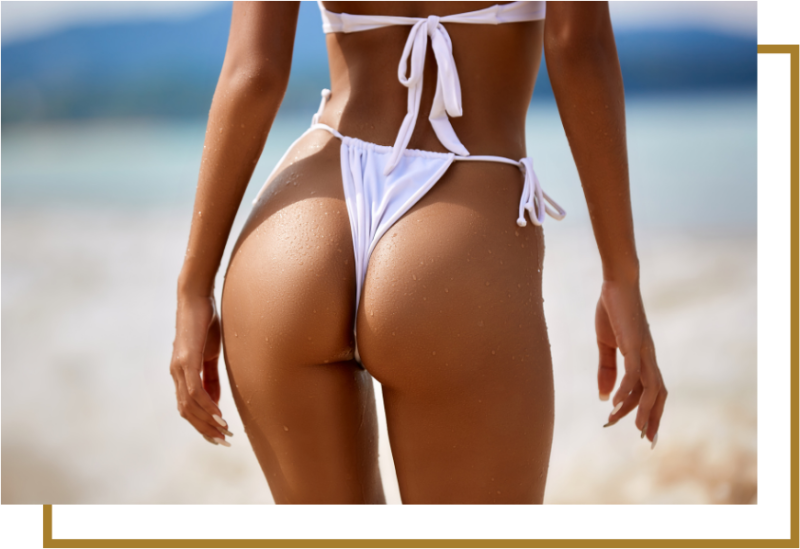Brazilian Butt Lift (BBL) Reversal Surgery
– NEWPORT BEACH, CA –While the Brazilian butt lift (AKA BBL) is still a popular procedure for buttocks enhancement and augmentation, there is an increasing number of patients that nowadays wish to reverse their Brazilian Butt Lift. A BBL is designed to enhance the shape and size of your buttocks with your own fat. During a Brazilian Butt Lift, fat is harvested from unwanted areas of the body, such as the abdomen, back, or flanks, through liposuction and liposculpting. The harvested fat is then processed, washed, and injected as microdroplets throughout the fatty layer of the buttocks to create a fuller and more lifted appearance.
But recently many patients have been looking to reverse their buttock augmentation procedures and achieve a more natural look to the point that some claim to be the “end of the BBL era” lead by celebrities like Kim and Khloé Kardashian. Patients may wish to reverse or undo the results of a BBL due to various reasons, such as dissatisfaction with the outcome, complications, or changes in personal preference.
For some, the result of a BBL may be unwelcomed when the
newly created buttock size does not match the rest of the patient’s body. This can happen when large volume fat transfer is performed in order to create an excessively larger buttocks. This is more common in States such as Florida where this procedure is sought and desired by some patients.

Another cause of a mismatch between buttock size and a patient’s body is weight gain. Weight gain can result in further expansion of the fat cells within the buttocks and thus additional buttocks enlargement. Unfortunately, this enlargement may not always proceed uniformly and thus may create a less than desired buttocks shape. Another reason for BBL reversal popularity is changes in personal preferences.
Over time, an individual’s aesthetic preferences and desires may change, and they might no longer desire the enhanced appearance achieved through a BBL.
Some plastic surgeons believe the BBL reversal is as simple as buttocks liposuction, but our Board-Certified surgeon and body contouring expert, Dr. Siamak Agha alerts that liposuction can only work to a certain extent, and only for patients with a high degree of skin elasticity.
How is BBL Reversal Achieved?
Most surgeons offer BBL reversal by removing the transferred fat via liposuction.
However, this approach can result in loose buttock skin that can appear as contour irregularities, just like a weight loss patient. The presence of loose skin after buttocks liposuction can vary depending on several factors, including the elasticity of your skin, the amount of fat removed, and your age. Here are some key points to consider.

As you may appreciate, not everyone will be able to have BBL reversal with liposuction only. As a body and buttock surgery expert, Dr. Agha has performed over 600 buttocks enhancement, buttocks reduction, buttocks lift, and buttocks reshaping procedures in his practice and has pioneered his own signature procedure that he routinely performs on his BBL reversal and body lift patients.
The choose of the technique needed is dictated by several factors:
- How big are the buttocks relative to the rest of the patient?
- How much reduction is desired?
- Is there buttock sagging and laxity?
- Are there buttocks cellulites and dimples?
- How much reduction is desired?
To simplify what is needed, Dr. Agha has developed the following algorithm:
Thus, for most patients, liposuction by itself will not produce the best outcome since it will also result in buttock skin laxity and dimpling. On the other hand, Dr. Agha’s signature buttock restoration technique not only reduces the buttock volume, but it also lifts the buttocks and reshapes them to result in a perkier but smaller version of your buttocks. This approach is custom-made for each patient and Dr. Agha is also able to change the buttock shape from a boxy or V-shaped butt to a round or heart-shaped buttocks.
It is important to note that any surgical procedure comes with potential risks and complications, and reversing a BBL may have its own set of risks as well. If you are considering a BBL or its reversal, it is crucial to consult with a qualified and experienced plastic surgeon such as Dr. Agha to discuss the options, potential outcomes, and associated risks specific to your situation. Always prioritize your safety and make informed decisions about any cosmetic procedure.
How Do You Recover from a BBL Reversal?
Following the procedure, you will need to follow your surgeon’s post-operative instructions for a smooth recovery. This may include wearing compression garments, avoiding sitting or putting pressure on the treated area for a certain period, and taking prescribed medications to manage pain and reduce the risk of infection.
